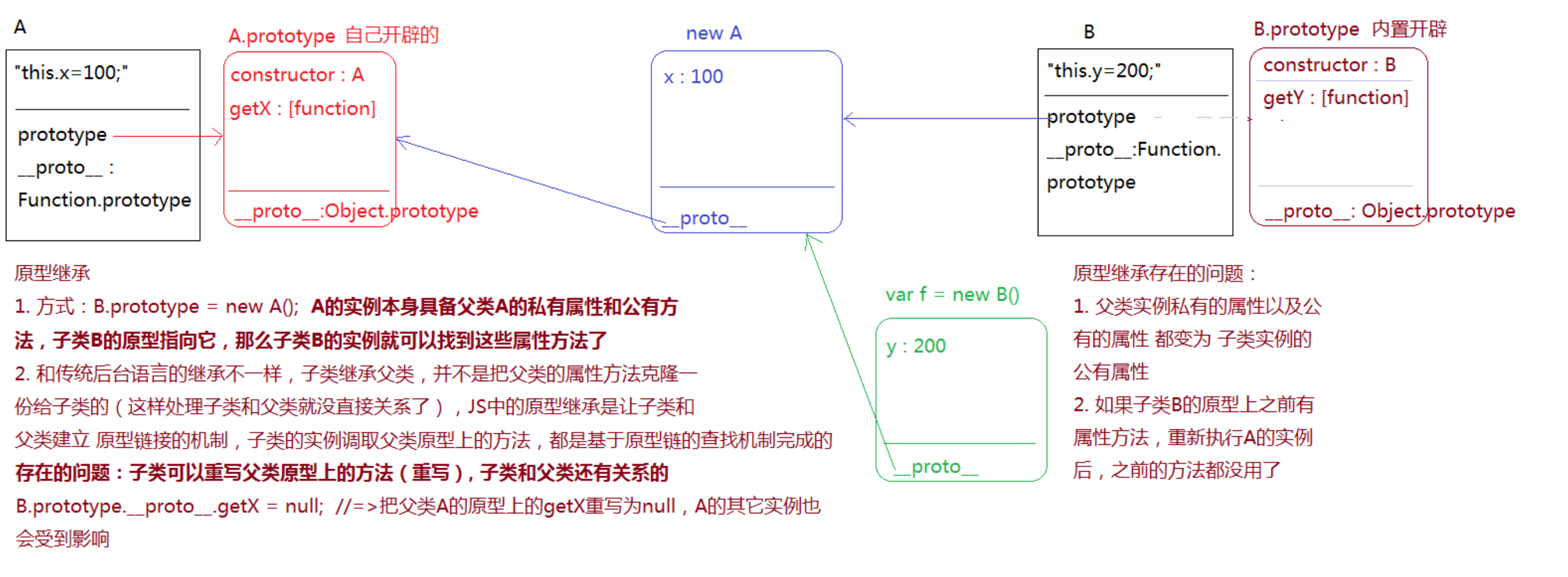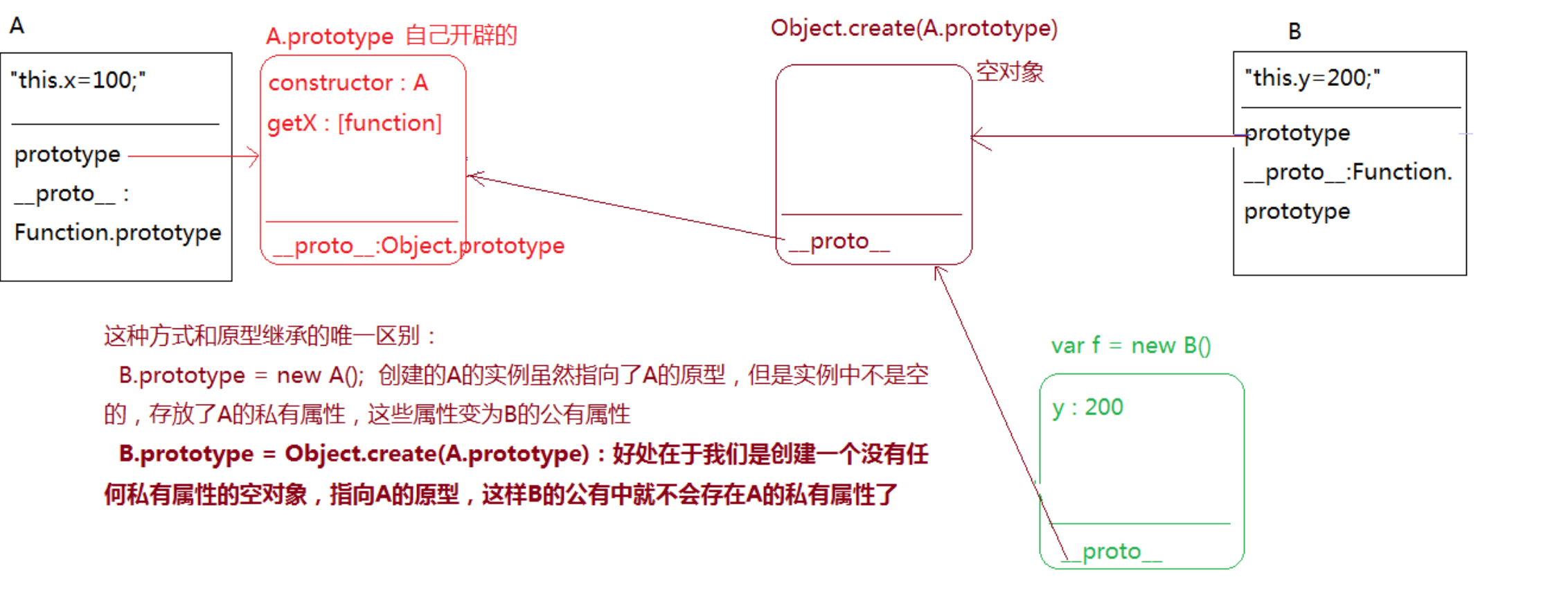~~~
/*
* 面向對象:類的繼承封裝和多態
* [封裝]
* 把實現一個功能的JS代碼進行封裝,主要目的:“低耦合高內聚”
*
* [多態]
* 重載:方法名相同,參數的個數或者類型不同,此時名字相同的方法叫做方法的重載(后臺語言中的重載),JS中不存在重載的
* 重寫:子類重寫父類的方法
*
* [繼承]
* 子類繼承父類的屬性和方法
* 1. 原型繼承
* 2. call繼承
* 3. 寄生組合繼承
* 4. ES6中class類實現繼承
* ...
*/
// public void fn(int n,int m){
//
// }
// public void fn(string n,string m){
//
// }
// public void fn(int n,int m,int z){
//
// }
// //=>根據傳遞參數的不同執行不同的方法
// function fn(n, m) {
//
// }
//
// function fn(n, m, x) {
// //=>后面的方法會把前面的方法覆蓋掉,不管傳遞多少實參,執行的都是后面的這個方法(JS中的重載指的是:同一個方法根據傳參不一樣,實現不同的功能)
// }
//
// fn(10, 20);
// fn(10, 20, 30);
//=>原型繼承:讓子類的原型指向父類的一個實例
// function A() {
// this.x = 100;
// }
// A.prototype = {
// constructor: A,
// getX: function () {
// console.log(this.x);
// }
// };
// function B() {
// this.y = 200;
// }
// B.prototype = new A();
// let f = new B();
//=>CALL繼承:把父類A做為普通函數執行,讓A中的THIS變為B的實例,相當于給B的實例增加一些屬性和方法(弊端:把父類A當做普通函數執行,和父類原型沒啥關系了,僅僅是把A中的私有屬性變為子類B實例的私有屬性而已,A原型上的公有屬性方法和B及它的實例沒啥關系)
//new A() 把A作為類創建它的實例 this:實例
//A() 把A作為普通函數執行 this:window
// function A() {
// //=>this:f
// this.x = 100; //=>f.x=100
// }
// A.prototype = {
// constructor: A,
// getX: function () {
// console.log(this.x);
// }
// };
// function B() {
// //=>this:f
// A.call(this);//=>call繼承 把A執行,讓A中的this變為f
// this.y = 200;
// }
// let f = new B();
//=>寄生組合繼承:A的私有變為B的私有,A的公有變為B的公有
// function A() {
// this.x = 100;
// }
// A.prototype = {
// constructor: A,
// getX: function () {
// console.log(this.x);
// }
// };
// function B() {
// A.call(this);//=>基于CALL把A的私有變為B的私有 f.x=100
// this.y = 200;
// }
// // B.prototype = A.prototype; //=>一般都不這樣處理,因為這種模式可以輕易修改父類A原型上的東西(重寫“太方便”了),這樣會導致A的其它實例也受到影響
// B.prototype=Object.create(A.prototype);
// let f = new B();
/*
* Object.create:內置Object類天生自帶的方法
* 1.創建一個空對象
* 2.讓新創建的空對象的__proto__指向第一個傳遞進來的對象(把OBJ作為新創建空對象的原型)
*/
// let obj={
// name:'哈哈'
// };
// console.log(Object.create(obj));
//=>ES6中的類和繼承
//1.ES6中創建類是有自己標準語法的(這種語法創建出來的類只能NEW執行,不能當做普通函數執行)
// class Fn {//=>Fn是類名,沒有小括號
// constructor(n, m) {
// //=>等價于傳統ES5類的構造體
// this.x = n;
// this.y = m;
// }
//
// //=>給Fn的原型上設置方法(只能設置方法不能設置屬性)
// getX() {
// console.log(this.x);
// }
//
// //=>把Fn當做一個普通對象設置的私有方法(和實例沒有關系),同樣也只能設置方法不能寫屬性
// static AA(){
//
// }
// }
// // Fn.prototype.BB = 100;
// // Fn.xxx = 'xxx';
// let f = new Fn(10, 20);
// function Fn(n,m){
// this.x=n;
// this.y=m;
// }
// Fn.prototype.getX=function(){}
// Fn.prototype.BB=100;
// Fn.AA=function(){} //=>把Fn當做一個普通對象設置的私有方法(和實例沒關系)
class A {
constructor() {
this.x = 100;
}
getX() {
console.log(this.x);
}
}
class B extends A {//=>extends類似于實現了原型繼承
constructor() {
super();//=>類似于CALL繼承:在這里SUPER相當于把A的CONSTRUCTOR給執行了,并且讓方法中的THIS是B的實例,SUPER當中傳遞的實參都是在給A的CONSTRUCTOR傳遞
this.y = 200;
}
getY() {
console.log(this.y);
}
}
let f = new B();
~~~


- 1.變量提升、閉包、THIS、OOP
- 0002.NODE安裝及一些基礎概念
- 0003.常用的DOS命令
- 0004.基于npm包管理器下載所需資源
- 0005.簡單操作一遍gitHub
- 0006.集中式vs分布式版本控制系統
- 0007.簡述git安裝
- 0008.基于git創建一個空倉庫
- git-svn區別
- 0009.git的工作流程
- 0010.完成本地git倉庫個遠程gitHub倉庫的信息同步
- 0011.JS數據渲染機制及堆棧內存
- 0012.變量提升機制
- 0013.帶VAR和不帶的區別
- 0014.作用域鏈的一些擴展
- 0015.變量提升的一些細節問題(關于條件判斷下的處理)
- 0016.條件判斷下的變量提升到底有多坑
- 0017.變量提升機制下重名的處理
- 0018.ES6中的LET不存在變量提升
- 0019.JS中的暫時性死區問題
- 0020.區分私有變量和全局變量
- 0021.有關私有變量和作用域鏈的練習題
- 0022.上級作用域的查找
- 0023.閉包及堆棧內存釋放
- 0024.閉包作用之保護
- 0026.單例設計模式的理論模型
- 0027.強化高級單例模式理論模型
- 0028.實戰項目中的模塊化
- 0029.沒有什么實際意義的工廠模式
- 0030.JS是基于面向對象開發設計的語言
- 0031.創建值的兩種方式以及區別
- 0032.構造函數執行的機制
- 0033.構造函數中的一些細節問題
- 0034.原型鏈和原型鏈的查找機制
- 0045.練習題講解[19]-關于原型重定向問題綜合練習
- 0035.練習題講解[01-05]
- 0036.練習題講解[06~08]-JS中的嚴格模式和ARG的映射機制
- 0037.課件3&練習題講解[09]-邏輯或和邏輯與
- 0038.課件4&練習題講解[10]-有關堆棧內存釋放
- 0039.課件5&練習題講解[11~13]
- 0040.課件6&練習題講解[14]-堆棧內存和this混合應用題
- 0041.課件7&練習題講解[15]-構造函數和原型鏈的運行機制
- 0042.課件8&練習題講解[16]-基于閉包解決循環綁定
- 0043.課件9&練習題講解[17]-有關this的兩道面試題
- 0044.課件10&練習題講解[18]-關于原型重定向問題
- 0045.課件11&練習題講解[19]-關于原型重定向問題綜合練習
- 0046.課件12&練習題講解[20]-數組去重引發的基于內置類原型擴展方法,并且實現鏈式調用
- 0047.課件13&練習題講解[其余隨性題]-閉包和團隊協作開發
- 0049.課件1&LESS學習-如何編譯less
- 0050.課件2&LESS學習-less中最常用的一些基礎語法
- 總結
- 數組常用方法
- 2.原型深入、THIS、商城排序、正則
- 0051.原型深入1-函數的三種角色
- 0052.原型深入2-基于阿里的面試題理解函數的三種角色
- 0053.原型深入3-原型鏈機制最終版(Function)
- 0054.原型深入4-深入理解原型和CALL
- 0055.原型深入5-call、apply、bind三者的區別
- 0056.原型深入6-基于APPLY獲取數組中的最大值
- 0057.數組和對象的解構賦值
- 0058.剩余和展開運算符
- 0059.把類數組轉換為數組
- 0060.原型深入8-基于ES6的方式把類數組轉換為數組
- 0061.ES6-箭頭函數
- 0062.課件1&商城排序1-基于AJAX獲取數據(不講AJAX)
- 0063.課件2&商城排序2-把獲取的JSON字符串轉換為對象
- 0064.課件3&商城排序3-基于ES6模板字符串完成數據綁定
- 0065.課件4&商城排序4-按照價格升序排序
- 0066.課件5&商城排序5-簡述DOM映射機制
- 0067.課件6&商城排序6-按照價格升降序切換
- 0068.課件7&商城排序7-實現多列升降序切換
- 0069.課件8&商城排序8-解決多列切換中的一點BUG
- 0070.課件9&商城排序9-如何學習和練習項目案例
- 0071.課件10&復習商城排序1-基于LESS實現樣式
- 0072.課件11&復習商城排序2-高級單例模式框架結構
- 0073.課件12&復習商城排序3-數據獲取和綁定
- 0074.課件13&復習商城排序4-學習DOM映射和告別DOM映射
- 0075.課件14&復習商城排序5-完成事件綁定的邏輯
- 0076.課件15&復習商城排序6-由數據綁定引發的DOM性能優化
- 0077.課件1&正則基礎概念和常用的元字符梳理
- 0078.課件2&中括號的一點特殊細節
- 0079.課件3&分組的三個作用
- 0080.課件4&常用的正則表達式
- 0081.課件5&正則捕獲的懶惰性和解決方案
- 0082.課件6&正則捕獲的貪婪性和分組捕獲
- 0083.課件7&更多的捕獲方式(REPLACE)
- 0084.課件8&處理時間字符串格式化
- 3.Dom盒子模型、JQ
- 0086.課件1&考試題講解-第一次考試題[01~03]
- 0087.課件2&考試題講解-第一次考試題[04]
- 0088.課件3&考試題講解-第一次考試題[05]
- 0089.課件4&考試題講解-第一次考試題[06~08]
- 0090.課件5&考試題講解-第二次考試題[01~05]
- 延時打印-無視頻
- 0091.課件1&DOM盒子模型1-復習常用的DOM操作屬性和方法
- 0092.課件2&DOM盒子模型2-JS盒子模型屬性第一部分
- 0093.課件3&DOM盒子模型3-獲取元素的具體樣式
- 4. 前三周綜合復習
- 0112.課件1&ES6新語法和DOM回流
- 0113.課件2&關于面向對象的理解
- 0114.課件3&關于THIS匯總
- 0115.課件4&作用域鏈和原型鏈
- 0116.課件5&數組去重
- 0117.課件6&遞歸算法和數組扁平化
- 0119.課件8&ES6中的類及繼承
- 0120.課件9&正則的一點應用
- 0121.課件10&關于對閉包的理解
- 0122.課件11&閉包、THIS、面向對象綜合練習題
- 0123.課件12&復雜一些的正則
- 0124.課件13&拿正則搞各種需求
- 0125.課件14&一些雜七雜八的題
- 0126.課件15&圖片延遲加載
- 0127.課件16&柯理化函數編程思想
- 5.定時器、異步、動畫庫、輪播
- 0129.課件1&定時器基礎知識
- 0130.課件2&JS中的同步異步編程核心原理
- 0131.課件3&初識Promise
- 0135.課件7&回調函數原理和實戰
- NODE和PROMISE-34
- 024-[PROMISR A+]-復習PROMISR的使用
- 022-重點***[專題匯總]-JS中的同步異步(宏任務和微任務)
- 6.事件、事件委托、發布訂閱
- 1.事件和事件委托
- 149.課件1&事件的理論基礎
- 150.課件2&事件對象中常用的屬性
- 151.課件3&事件對象的兼容問題
- 152.課件4&默認行為及阻止
- 153.課件5&事件傳播機制(很重要)
- 158.課件10&事件委托
- 161.課件13&基于事件委托實現無限級折疊菜單
- 169.課件8&[拖拽]擴展柯理化函數編程思想
- 2.DOM事件綁定、發布訂閱
- 162.課件1&DOM0和DOM2的運行機制(事件池機制)
- 163.課件2&DOM2事件綁定的兼容問題
- 7.移動端開發
- 8.AJAX
- 226.課件14&14-基于PROMISE解決回調地獄問題
- 9.AXIOS視頻
- node和promise
- 22-[專題匯總]-JS中的同步異步(宏任務和微任務)
- REACT
